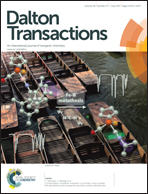A highly selective fluorescent sensor for Al3+ and the use of the resulting complex as a secondary sensor for PPi in aqueous media: its applicability in live cell imaging†
Abstract
An easy-to-make salicylimine (L) bearing an “O–N–O”-coordination site was used as a highly selective fluorescent sensor for Al3+ and PPi in aqueous solution. Sensor L showed a significant fluorescence enhancement in the presence of Al3+ over other competitive metal ions. It works based on the Al3+-induced formation of a 1 : 1 L–Al3+ complex, producing a chelation-enhanced fluorescence effect, the fluorescence quantum yield reached 0.59. This L–Al3+ ensemble is a subsequent fluorescent sensor for PPi due to the strong attraction between Al3+ and PPi, it can selectively discriminate PPi overcoming the interference of the biological competitors including PO43−, ADP and ATP at physiological pH. L and L–Al3+ exhibit high sensitivity and selectivity for Al3+ and PPi, the detection limits were found to be as low as 2.94 × 10−8 M and 2.74 × 10−7 M, respectively. It was further confirmed that sensor L had potential practical applications through mapping of Al3+ in live cells.


 Please wait while we load your content...
Please wait while we load your content...